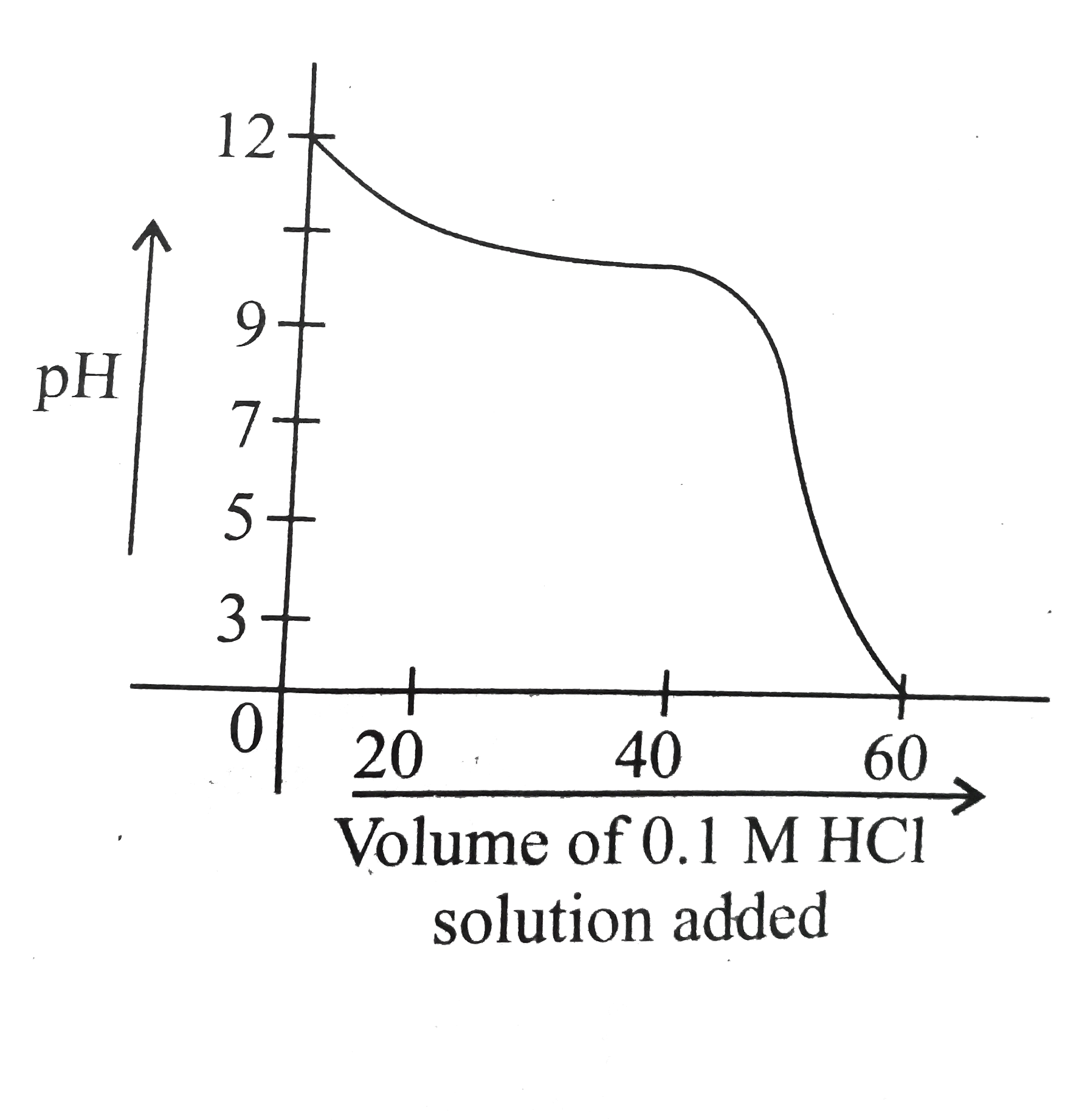Complete Solutions to Exercises Multiple Correct of chapter IONIC EQUILIBRIUM of Class 11 book with complete answers and questions
| Class 11 | CHEMISTRY |
| Chapter | IONIC EQUILIBRIUM |
| CENGAGE CHEMISTRY | Exercises Multiple Correct |
| Number Of Questions | 33 |
| Academic Year | 2023-24 |
`0.1mol` of `RNH_(2)(K_(b) = 5 xx 10^(-4))` is mixed with `0.08mol` of `HC1` and diluted to `1L`. Calculate the `[H^(o+)]` in the solution.
View SolutionWhen weak base solution `(50mL of 0.1 N NH_(4)OH)` is titrated with strong acid `(0.1N HCI)`, the `pH` of the solution initially decrease fast and then decreases slowely till near the equivalence point (as shown in figure). Which of the following is//are correct.

View SolutionWhich of the following statements about a weak acid strong base titration is//are correct?
View SolutionAn acid-base indicator has `K_(a) = 10^(-5)`. The acid form of the indicator is red and basic form is blue. Which of the following is//are correct?
View SolutionWhen HCI gas is passed through a saturated solution of common salt, pure NaCI is Precipitated because:
View SolutionExcess of `Ag_(2)SO_(4)(s), BaSO_(4)(s)`, and `Ba_(3)(PO_(4))_(2)(s)` are simultaneously in euqilibrium with distilled water. Which of the following is (are) true? Assume no hydrolysis of dissolved ions.
View SolutionA solution is found to contain `[CI^(Theta)] = 1.5 xx 10^(-1)M, [Br^(Theta)] = 5.0 xx 10^(-4)M, [CrO_(4)^(2-)] = 1.9xx 10^(-2)M`.
A solution of `AgNO_(3)` (100 % dissociated) is added to the above solution drop by drop. Which silver salt will precipiate first ? Given: `K_(sp) (AgCI) = 1.5 xx 10^(-10), K_(sp) (AgBr) = 5.0 xx 10^(-13),K_(sp) (Ag_(2)CrO_(4)) =1.9 xx 10^(-12)`.
View Solution`HgCrO_(4)` just begins to peripitate when equal volumes of `4 xx 10^(-4)M Hg_(2)(NO_(3))_(2)` and `2 xx 10^(-5)M K_(2)CrO_(4)` are combind. What is the approximate `K_(sp)` value of `Hg_(2)CrO_(4)`?
View SolutionWhat is general criteria of choosing a suitable indicator for a given titration?
View SolutionWhich of the following are true for an acid- base titration?
View SolutionAn acid-base indicator has `K_(a) = 3.0 xx 10^(-5)`. The acid form of the indicator is red and the basic form is blue. Then:
View SolutionAt the end point, there is a sharp change of colour in the indicator. This happened because the
View SolutionFor a series of indicators, the colour and `pH` range over which colour change takes place are as follows:
`{:("Indicator",,"Colour change over pH range"),(U,,"Yellow to blue pH 0.0 to 1.6"),(V,,"Red to yellow pH 2.8 to 4.1"),(W,,"Red to yellow pH 4.2 to 5.8"),(X,,"Yellow to blue pH 6.0 to 7.7"),(Y,,"Colourless to red pH 8.2 to 10.0"):}`
Which of the following statements is correct ?
View Solution`H_(3)PO_(4)hArr H^(o+) +H_(2)PO_(4)^(Theta), K_(a_(1))`:
`H_(2)PO_(4)^(Theta) hArr H^(o+) +HPO_(4)^(2-),' K_(a_(2))`:
`HPO_(4)^(2-) hArr H^(o+) + PO_(4)^(3-), K_(a_(3)):`
Mark out the incorrect statements:
View SolutionAqueous solution of `HNO_(3),CH_(3),CH_(3)COOH`, and `CH_(3)COOK` of identical concentrations are given. The pair (s) of the solution which may form a buffer upon mixing is (are):
View SolutionTo which of the solution, addition of water would not effect the `pH` ? .
View SolutionWhich of the following salt solutions has `pH lt7` ? .
View SolutionWhich of the following represents hydrolysis ? .
View SolutionThe `pH` values of aqueous solutions of which of the following compounds does not change on dilution?
View SolutionIn `H_(3)PO_(4)` which of the following is true?
View SolutionDegree of hydrolysis `(alpha)` for a salt of strong acid and weak base is :
View SolutionA solution containing a mixture of `0.05M NaCI` and `0.05M` Nal is taken. `(K_(sp) of AgCI = 10^(-10)`and `K_(sp)`of `AgI = 4 xx 10^(-16))`. When `AgNO_(3)` is added to such a solution:
View SolutionWhich of the following is(are) correct when `0.1L` of `0.0015M MgCl_(2)` and `0.1L` of `0.025M NaF` are mixed togther? `(K_(sp) of MgF_(2) = 3.7 xx 10^(-8))`.
View SolutionChoose the correct statement:
View SolutionWhich of the following is (are) correct for buffer solution?
View SolutionA solution is prepared by dissolving `1.5g` of a monoacidic base into `1.5 kg` of water at `300K`, which showed a depression in freezing point by `0.165^(@)C`. When `0.496g` of the same base titrated, after dissolution, required `40 mL` of semimolar `H_(2)SO_(4)` solution. If `K_(f)`of water is `1.86 K kg mol^(-1)`, then select the correct statements (s) out of the following( assuming molarity `=` molarity):
View SolutionA solution of `0.01M Fe^(2+)` in a saturated `H_(2)S` solution and (i) `0.2M of H^(o+) (ii) 0.001M of H^(o+).(K_(1) xx K_(2) of H_(2)S = 10^(-21), K_(sp) FeS = 3.7 xx 10^(-19))`. Which of the following statements is//are correct
View SolutionWhich statements is//are correct?
View SolutionWhich statements is//are correct?
View SolutionWhich of the following solution will have `pH = 13`?
View SolutionWhich of the following statements (s) is (are) correct?
View SolutionThe `pH` of `0.1M` solution of the following salts decreases in the order
View SolutionA buffer solution can be prepared from a mixture of
View Solution
Exercises Multiple Correct questions and complete solutions for chapter IONIC EQUILIBRIUM of CENGAGE CHEMISTRY (ENGLISH) of Class 11
All Exercises from CENGAGE CHEMISTRY Class 11 CHEMISTRY IONIC EQUILIBRIUM
- Archives Fill In The Blanks
- Archives Integer
- Archives Multiple Correct
- Archives Single Correct
- Archives Subjective
- Archives True/False
- Ex 8.1
- Ex 8.2
- Ex 8.3
- Ex 8.4
- Ex 8.5
- Exercises Assertion-Reasoning
- Exercises Integer
- Exercises Linked Comprehension
- Exercises Multiple Correct
- Exercises Single Correct
- Exercises Subjective (Buffer Solutions)
- Exercises Subjective (Hydrolysis Of Salt)
- Exercises Subjective (Polyprotic Acid)
- Exercises Subjective (Weak Acid And Weak Bases)
- Exercises Subjective(Coordination Equilibria)
- Exercises True/ False
- Solved Examples